
On July 1939 Szilard convinced economist Alexander Sachs of the necessity of a strong American initiative in the military applications of fission, in order to counter the German developments. Szilard asked Einstein to write a letter to President Roosevelt outlining the dangers and opportunities of fission.
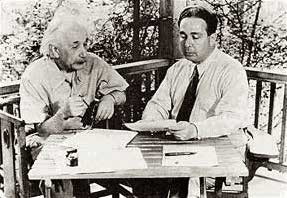
With the contribution of Edward Teller and Eugene Wigner the letter was prepared on August 2, 1939. Sachs presented the letter and a technical document by Szilard to Roosevelt on October 11, 1939, and the President immediately created an Advisory Committee on Uranium (ACU) under the chairmanship of government scientist Lyman J. Briggs.
Image right: A. Einstein and L. Szilard in August 1939. Below: the original Einstein-Szilard letter.


Priority was given to Fermi’s efforts in New York to produce a chain reaction with natural uranium and a graphite moderator, along with studies at several research laboratories into the separation of isotope 235U. At Berkeley the element 94 (plutonium) was discovered by Glenn Seaborg in February 1941 and its fission properties were studied by himself and Emilio Segrè. Its use as an alternative to 235U became an important option.
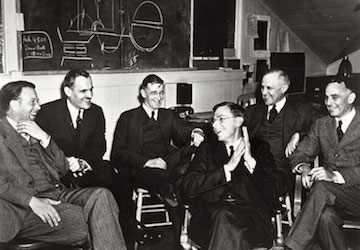
In June 1941, Vannevar Bush convinced Roosevelt of the necessity for scientists’ participation in the defence activities and in the development of new weapons. The Office of Scientific Research and Development (OSRD) is created, directly reporting to the President. ACU is put under the control of OSRD with the new name of 'Section S-1'. The involvement of industry in the production of pilot plants is recommended and stricter political control of the research is put in place.
Image above: The scientific leaders of the S-1 project: Ernest O. Lawrence, Arthur H. Compton, Vannebar Bush, James B. Conant, Karl T. Compton, Alfred L. Loomis (Berkeley March 29, 1940).On October 9, 1941 V. Bush presents the MAUD report, made available by the British, to Roosevelt and vice-president Henry A. Wallace. Roosevelt gives Bush full authority to investigate whether a bomb could be built and at what price with the necessary financing provided from a special presidential source. A strict secret status had to be maintained and the details of the collaboration with the UK had to be precisely defined. This event was of prime importance for the actual making of the bomb.
The collaboration had its difficulties, generated by the party who seemed to be more advanced in nuclear research at a given moment. In 1941 the British limited information to the Americans, in 1942 refused to include a British team in their program. The problems were compounded by the presence of the French scientists in the UK project and by the policy of patents. In January 1943 the communication was completely cut off. The collaboration was resumed with the August 17, 1943 Quebec trilateral agreement between Canada, UK and USA. UK stopped its bomb project and its scientists joined the US team, free exchange of information was ensured and each party has a right of veto on the use of the bomb.
After the USA entered the war in December 1941, the US nuclear program received the highest level of resources, without any budget limitations.
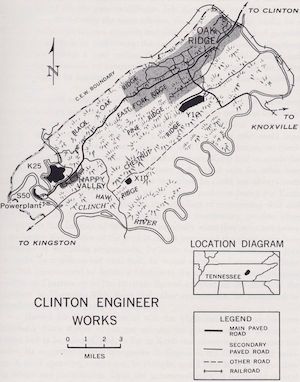
Arthur Compton in Chicago was in charge of reaching the chain reaction for the production of plutonium, Ernest Lawrence at Berkeley of the electromagnetic isotopic separation of 235U using specially designed cyclotrons. Harold Urey of the isotopic separation with centrifuges and gaseous diffusion.
General Leslie Groves is appointed in September 1942 military chief of the project, now called 'Manhattan Engineering District' (MED), and immediately assigns top priority to securing the necessary materials and selects an area of some 230 square km in Tennessee (Oak Ridge) for building the laboratories dedicated to the production of the fissile materials.
Image right: Map of the Oak Ridge complex built for the production of fissile materials. Within a few months this rural area saw the construction, in addition to huge laboratories, of a town with a population of 13000, and a paved road network of 500km. During the next year, the town reached 42000 inhabitants.Enrico Fermi’s experiements with higher quality piles of natural uranium and graphite made him confident in reaching a self-sustaining chain reaction.On November 16, 1942 he started the construction of a demonstration pile (CP1) in Chicago, with the assistance of Wigner for theoretical calculations.
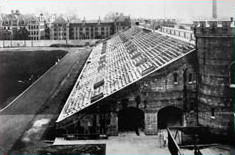
CP1 is immediately dismounted and the materials recovered for a larger pile, CP2, in the new laboratory in the Argonne forest near Chicago.
Image left: The West Stands of the Stagg Stadium of the Chicago University under which CP1 was built.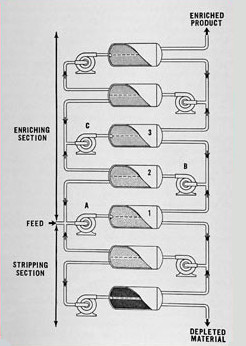
The electromagnetic separation method is based on the principle that charged objects undergo deflection when moving in a magnetic field. Heavier ions will be deflected to a lesser extent than lighter ions. Appropriately placed collectors can take advantage of this separation.
The diffusion method is based on the fact that the lighter molecules in a gas will have a higher average velocity than the heavier molecules. A compressed gas of a uranium compound is allowed to diffuse through a porous barrier: the slightly lighter 235U molecules have a higher chance to escape through holes (a fraction of a micron in diameter). Then the emerging gas, slightly enriched with the desired isotope (3 parts per 1000) is re-compressed and the process is repeated. At the Oak Ridge plant in 1945, the total surface area of the separation barrier reached thousands of square meters and produced uranium enriched to up to 10%.
Image above right: Schematic diagram of the flow of gas in a diffusion cascade.For the actual design of the bomb, J. Robert Oppenheimer, scientific director of MED, decided to gather all the necessary scientists and technical experts in a new secret laboratory, which was built at Los Alamos, a secluded mesa in New Mexico, during the winter of 1942-1943. On March 1943 the laboratory, under the responsibility of the University of California, began basic research to produce “a practical military weapon”. Several research apparata were transferred from around the USA: the Harvard cyclotron, two Van de Graaff accelerators from Wisconsin, a Cockcroft-Walton one from Illinois etc. The Los Alamos population doubled every 9 months, to reach over 5000 in 1945.
Oppenheimer, notwithstanding the military constraints, managed to keep the style of a scientific institution and to make the research work gratifying. Life there was hard but exciting and the contact with experienced scientists allowed young physicists to gain vital skills.
The road to plutonium starts from allowing 238U to absorb one neutron in a nuclear reactor operating with slow neutrons. After the prototype piles CP1 and CP2, industrial companies built three large reactors in a new secret center at Hanford (Washington) and one at Oak Ridge.
At Los Alamos, research on the chemical, physical and metallurgical properties of the new material proceeded as soon as plutonium was delivered, first in gram quantity and, from spring 1945, in substantial quantities, enough for the production of three bombs.On July 3, 1945 at Los Alamos the 235U bomb, called “Little Boy”, was completed. The fissile material was enriched up to 86% for 3 critical masses, each of about 60kg. Its detonation was based on the gun technique, using a gun 180cm long and weighing 453kg.
Little Boy was about 3m long, with a diameter of 70cm, small enough to fit into the bomb bay of a B-29 bomber, and had a total weight of about 4000kg. The scientists had complete confidence in its working ability and no preliminary tests were considered necessary.
The plutonium bomb “Fat Man” had a plutonium core weighting about 6.1kg and required detonation based on the implosion technique, in order to avoid pre-detonation, using some 2300kg of high explosive. The core, uranium tamper, and high explosives were held in place by a metal sphere made of twelve pentagonal sections. The weapon had stabilizing fins and a protective egg-shaped outer shell, 150cm in diameter. “Fat Man” was about 365cm long and weighed about 4900kg.
Image: The Fat Man bomb being prepared on Tinian in the Marianas for delivery on Nagasaki.The implosion technique was completely new and the preliminary partial tests did not give full-proof confidence.

Therefore, as enough plutonium was available, a final test of the complete bomb was performed at Alamogordo, in the New Mexico desert, at a site called Trinity in mid-July 1945.
The efficiency of the weapon was of 17% with a yield of 22kt. The test also allowed the checking of several technical details, but the main objective was to experience directly the effects of a nuclear explosion.None of the witnesses of the first nuclear explosion were prepared for the actual event: from the initial flash and the early fireball without any noise, from the silent heat of the light pulse, as simultaneous hard slaps on both cheeks, to the shock wave racing across the desert floor, and to the cloud of debris forming the ominous mushroom shape.
Image right: The initial fireball of the first ever nuclear explosion on Earth, July 16, 1945.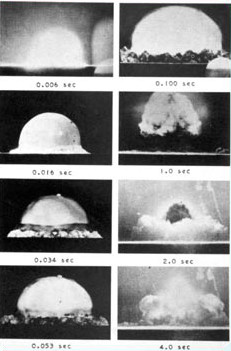
However, the main phenomena remain unchanged. The large energy produced in the short time of the explosion heats the materials to temperatures of several tens of millions of degrees and pressures of million times the atmospheric pressure are reached. Large quantities of energy are radiated mainly as X-rays, which are absorbed by the air, leading to the formation of an extremely hot and incandescent mass of air. This fireball grows in size and rises, decreasing its temperature. After a minute the light emission ceases and the cloud has risen to about 7km altitude.
The photo sequence on the left shows the first 4 seconds in the evolution of the explosion fireball during the Trinity test.In the early 1945 it became clear that the allies were winning the war both in Europe and in the Pacific. Several scientists started to discuss the social and political implications of the nuclear power and the consequences of actual usage of the bomb. In June 1945 James Frank’s report suggested to warn Japan and to demonstrate the power of the bomb in some uninhabited area, in face of its devastating effects. A Scientific Panel, composed by Compton, Fermi, Lawrence and Oppenheimer, was created to advise the Interim Committee, and reported the views of the scientists.
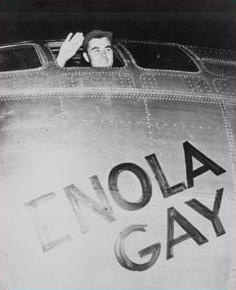
On the morning of August 6, 1945 at 8:15am, Little Boy was dropped on Hiroshima exploding 580m over the town, with a yield between 12kt and 15kt. On August 9, 1945 at 11:02am, Fat Man exploded 503m over Nagasaki; its yield was larger than 22kt. The two towns were destroyed, with more than a hundred thousand killed and a hundred thousand injured. Japan surrendered and World War II came to an end. The final decision to drop the bomb was both militarily driven, in order to avoid a high toll of lives when invading Japan, and political, to finish the war before Soviet Union could expand in the Pacific area.
Image: Col. Paul W. Tibbets, Jr., on his “Enola Gay” B52 bomber before the takeoff to Hiroshima.After the war, the perspectives of civilian and military nuclear power were starting being examined. The new American President, Harry S. Truman, creates an “Interim Committee” to decide about the use of the weapons and how to shape a nuclear program for the future. Among the decisions to be made was whether to proceed with international cooperation or follow a policy of an American monopoly.
But World War II was a turning point in the relations between scientists and governments. Scientists not only invented and built new weapons, they actively promoted them and participated in deciding when and how to use them, becoming full partners in the policy-making process.
The military and political success of the atomic bomb and the economic prospects of nuclear energy gave visibility and power to the scientific community everywhere. UK, Russia and France needed scientists to build their own nuclear arsenals. In the USA physicists obtained large financial support and were able to win, despite the wishes of the military establishment, the responsibility for controlling the development of nuclear energy. In the USA, the nuclear power policy was delegated to the Atomic Energy Commission, a body under civilian control.